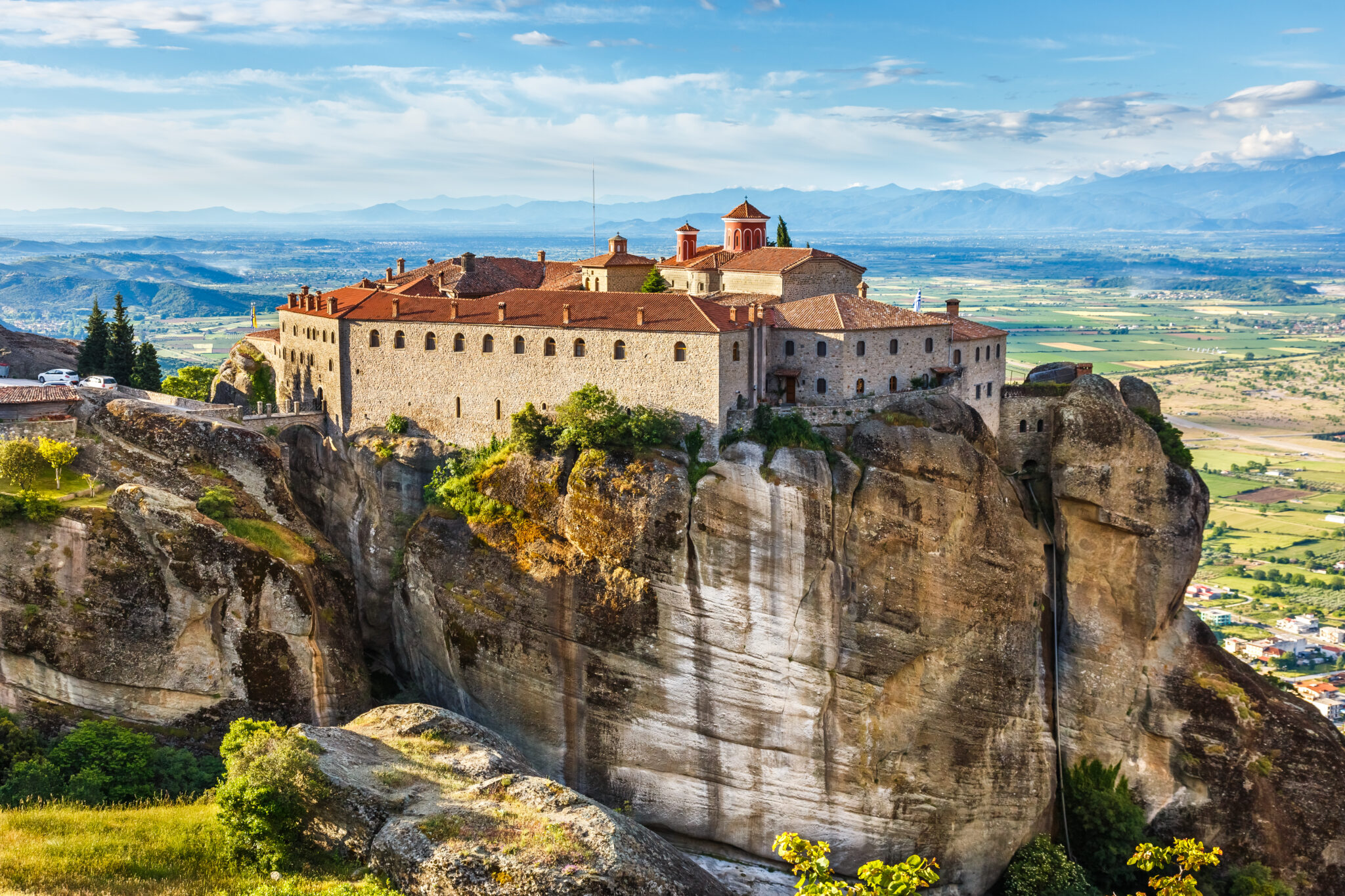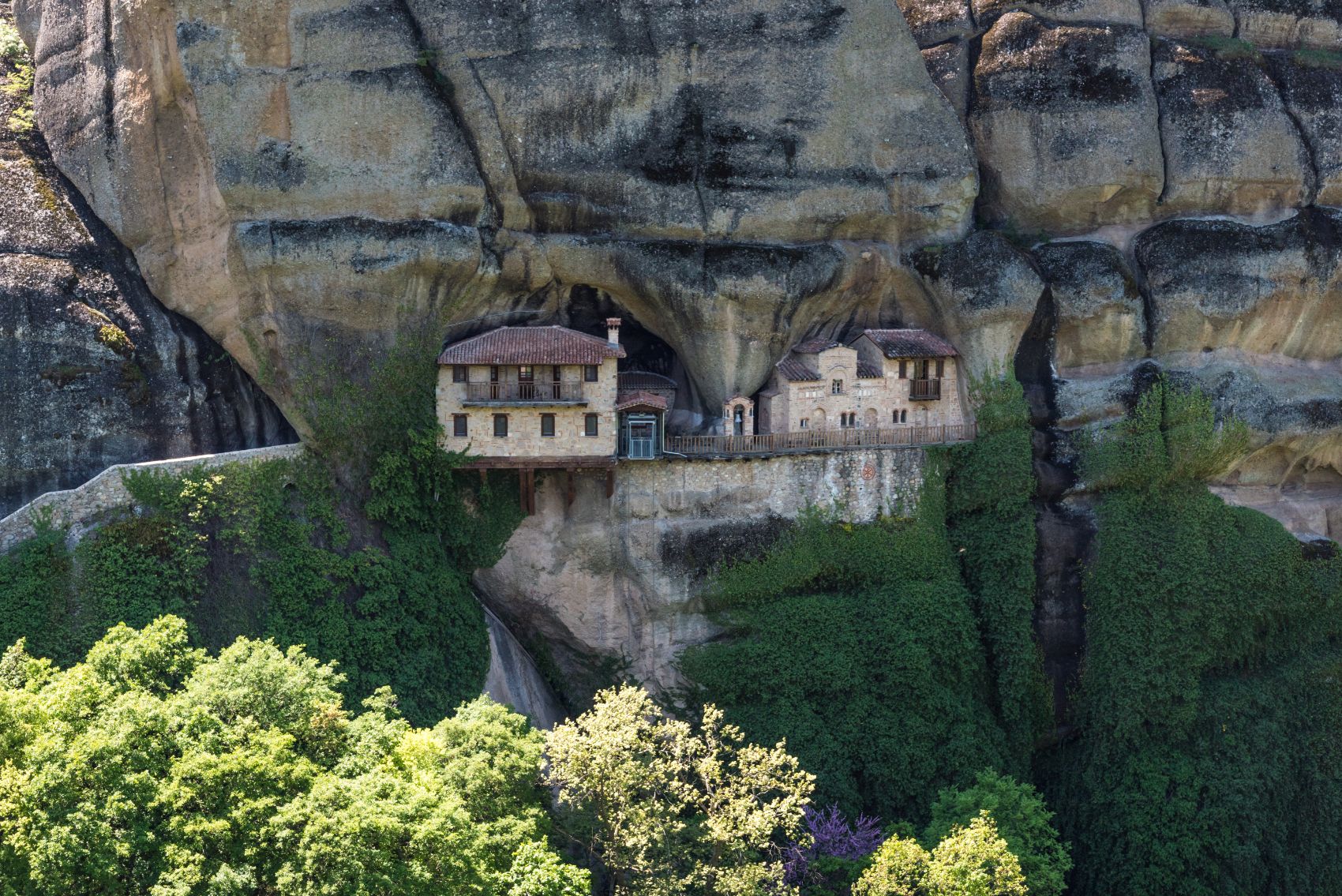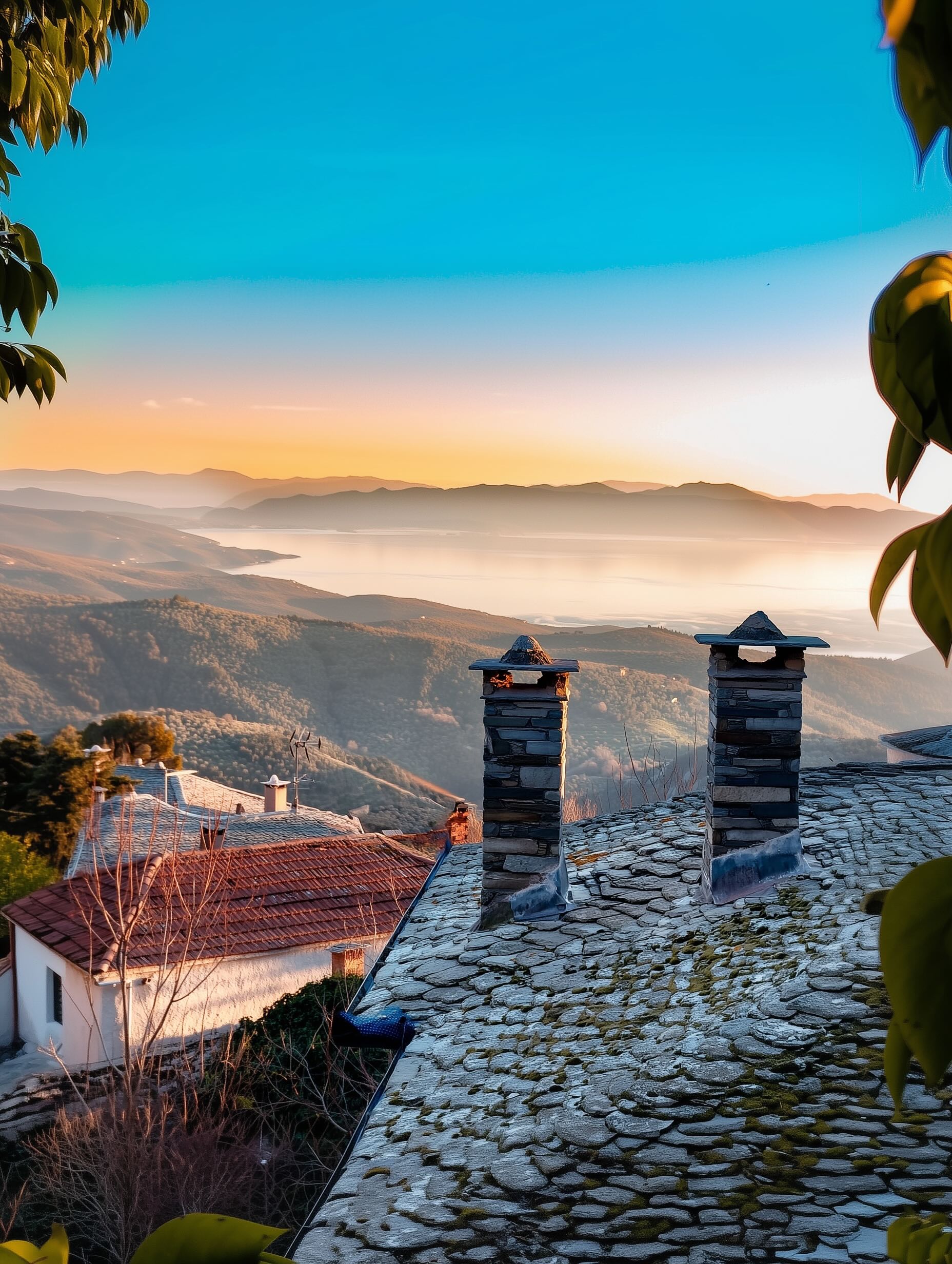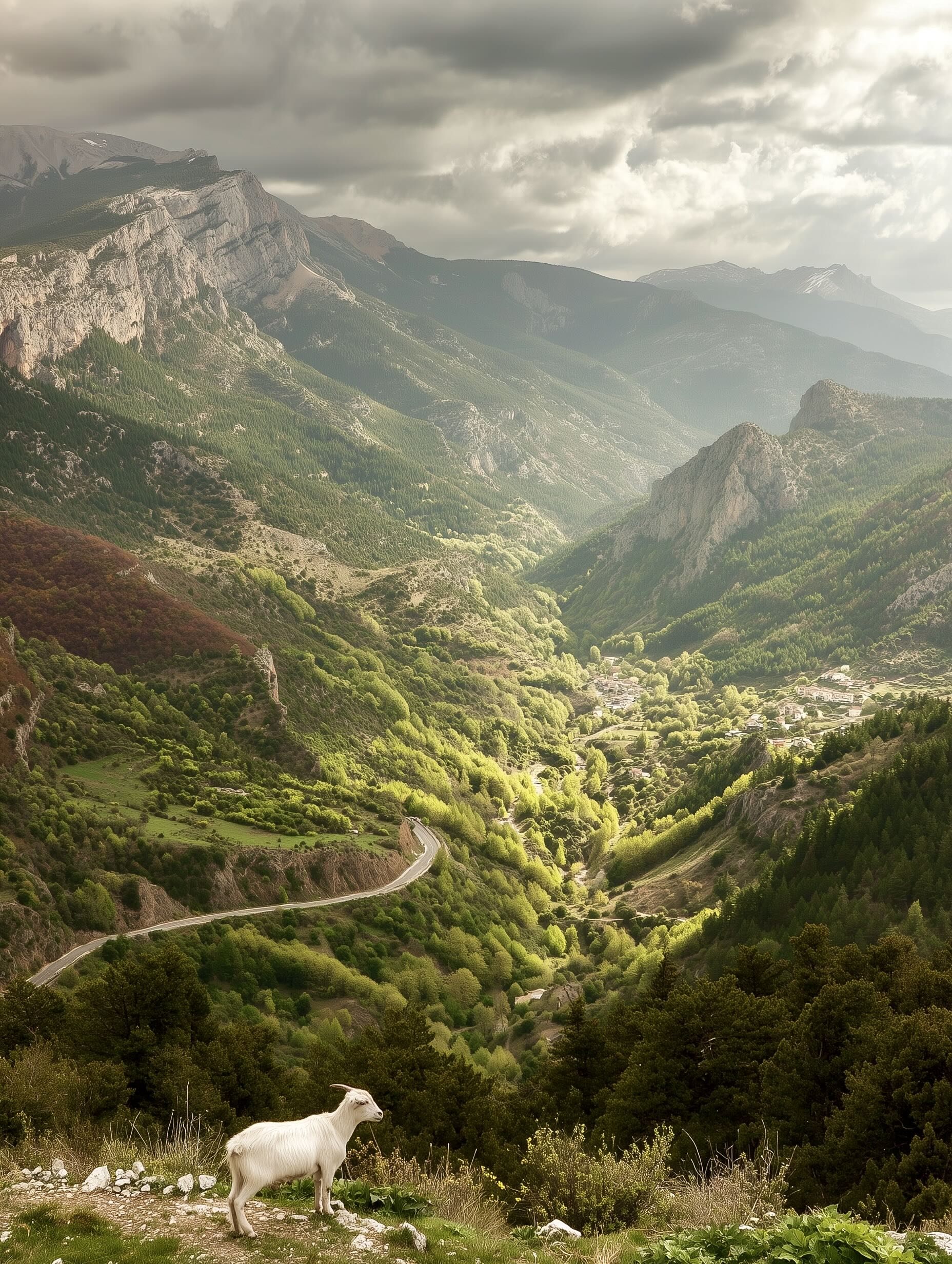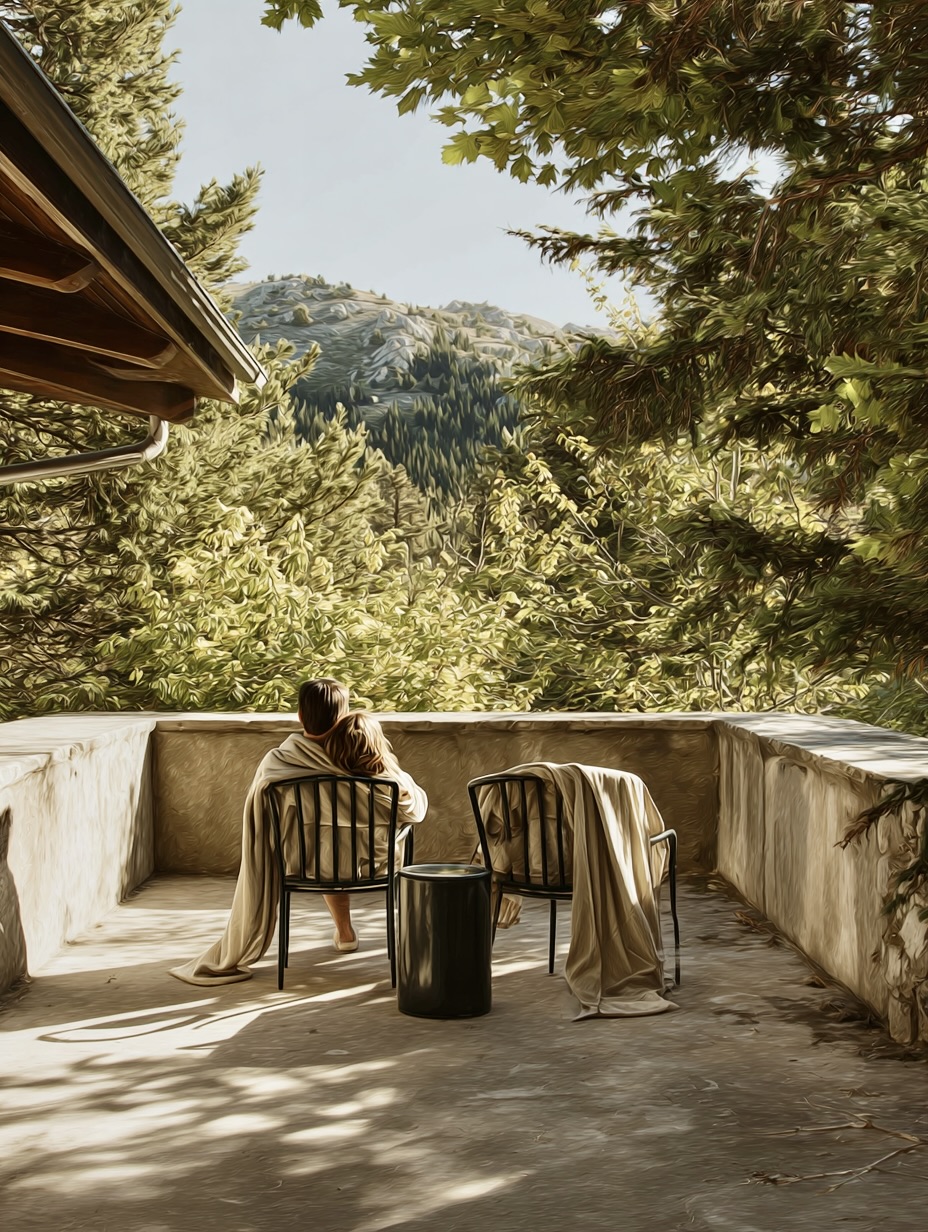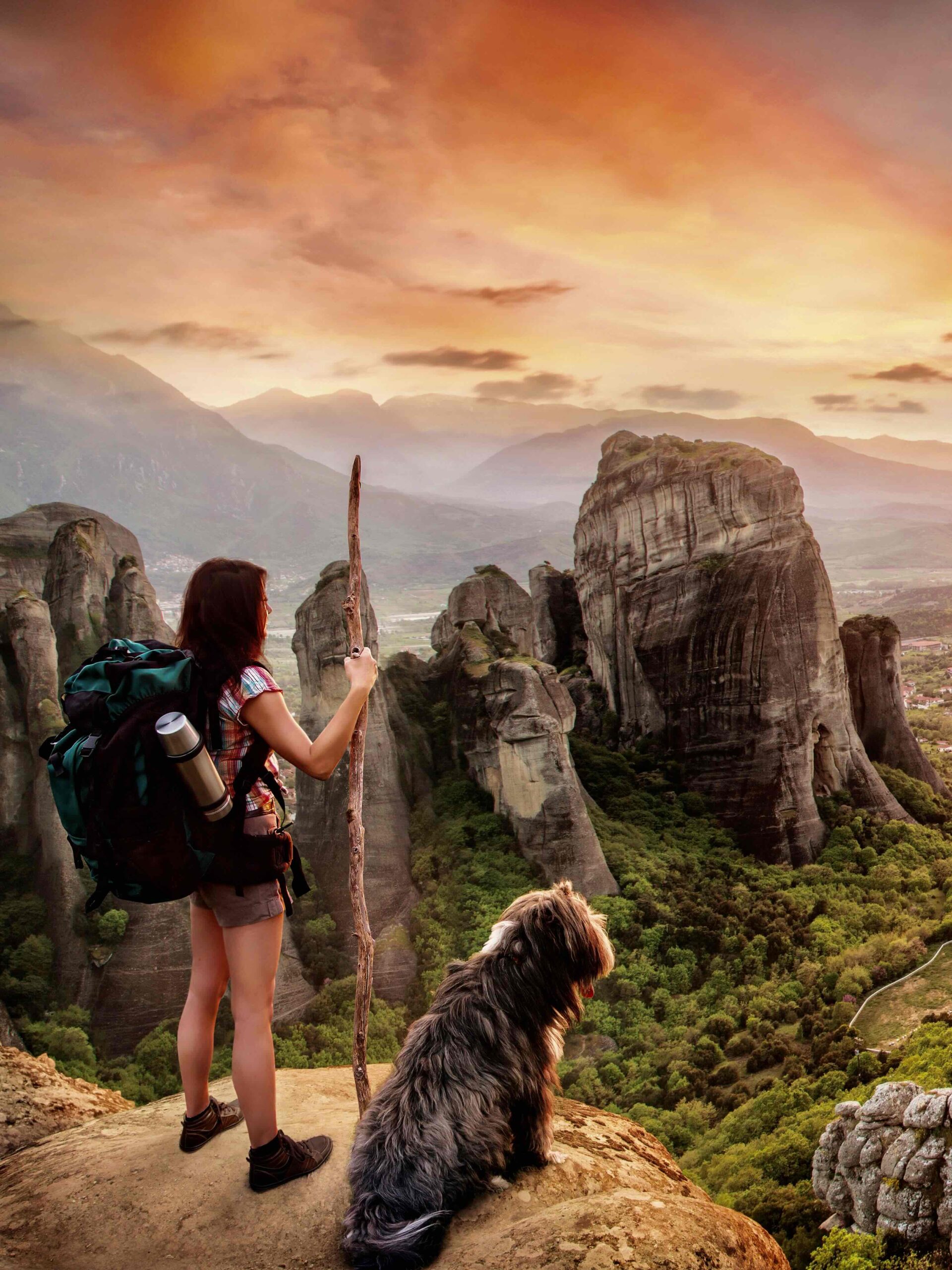At a cave, about 5km SE of Kalabaka, next to the village Theopetra, at the base of a rock like the Meteora rocks, archaeologists have discovered rich findings that show the uninterrupted presence of humans in the area from the Middle Palaeolithic era, that is about 130,000 years ago, until the end of the Neolithic era, that is around 3,000 BC. In this cave, and probably in other caves in the Meteora area, groups of Neanderthal lived, and then Homo Sapiens.
Despite being extremely impressive, ancient sources make no mention of the Meteora rocks. The ancient town of Aeginium, the largest town of the ancient Tymphaei, an Epirotic tribe of farmers that lived in mountains used to be in the same location as modern day Kalabaka, The land of Tymphaei was conquered by the Macedonians and incorporated in the Macedonian kingdom in the 4th century BC, but Aeginium continued existing and growing, and around the 9th AD century it changed name – it is not known why – and was called Stagi from then on. In the following Byzantine era, the town thrived and grew more and in fact became a base of Diocese. That is when the presence and domination of the Church began in this enchantingly beautiful place.
When the Franks abolished the Byzantine Empire in 1204, Stagi passed in the hands of the Despotate of Epirus, a state founded by Byzantine lords in exile in the region of Epirus and Thessaly. However, the area flourished in the years when Thessaly and Epirus were conquered by the Kingdom of Serbia between 1343 and 1417. The Serbians, being devout Orthodox Christians, particularly supported the monasteries in Meteora. In fact, their last king, John Ouresis Doukas Palaiologos, abandoned secular power to become a monk (and later a hegumen) at the largest monastery in Meteora, the Metamorfosi tou Sotira (Transfiguration of Jesus) monastery, also known as Megalo Meteoro (Great Meteoron).
When the Ottomans took over Constantinople in 1453, and completely ended the Byzantine Empire, they didn’t interfere with the monasteries, and in fact allowed them their many privileges and let them keep their land and riches, that kept growing. The 16th century is considered the Golden Century of Meteora: the churches were decorated and painted by the most famous painters of the time, the buildings were renovated and expanded, the monasteries were manned with cultured, educated monks that dedicated their time in producing manuscripts, and all of the monasteries – 30 in total – received land as donations by devout Christians, not just in the Meteora area and in the valley of Thessaly, but also in faraway regions like the countries of around the Danube. This wealth, as is to be expected, attracted various thieves, that during the period of the decline of the Ottomans, attacked and looted the area to such an extent that by the 18th century, most monasteries were abandoned and Meteora became a land of exile. The area suffered further attacks and damages during the German Occupation of Greece (1941-1944), as well as during the Greek Civil War (1945-1950). In 1960, the enormous effort to restore and preserve the monasteries began, with funding from the Ministry of Culture and from the European Union. Today six monasteries are in operation and open to visitors, and, since 1988, they have been listed in the UNESCO Cultural Heritage Monument List.
Natural environment
Meteora belongs to the Natura 2000 network (code GR1440005) and includes wooded hills with impressive steep rocks, the riverfront valley of rivers Pinios and Litheos, plane and oak forests, areas covered in bushes, as well as farmland. The flora includes many endemic species: Centaurea kalambakensis, Centaurea lactiflora, and protected species Anthemis cretica. The area is important for the reproduction of the birds and includes populations of protected species like the Egyptian vulture (Neophron percnopterus), owls, eagles and other birds of prey. In addition, there are otters (Lutra lutra) and wolves in the area of Meteora, various bats, tortoises, European rat snakes, forest dormice, Balkan green lizards, alpine newts, Eurasian vipers, Balkan whip snakes, smooth snakes, marginated tortoises, etc. However, this habitat is endangered by the logging of the oak forests, the expansion of the road network, illegal hunting, overgrazing, the lighting of the rocks with gigantic spotlights, and the mass tourism brought about by the local monasteries
Monasteries
The monastery of Metamorfosi tou Sotira (Great Meteoro): in theory it’s a monastery, but in essence it’s a museum. Everything here is a valuable exhibit. The first church that Athanasios the Athonite built here, around 1340, was dedicated to the Virgin Mary, but later (1387-1388) he built another church dedicate to the Transfiguration of Jesus. This was the church that some years later the king-monk Joasaph renovated. Only some parts of this church still survive, that have been incorporated into a more recent, third church built between 1544-1545 that is the monastery’s church. The original frescoes haven’t survive. The oldest existing frescoes date to 1483 and are inside the altar. What’s even more impressive is that parts of the actual ktetors (founders of the churches) survive; in particular, the skull of Athanasios the Athonite and that of Joasaph, kept in silver reliquaries. Wherever you look, you’ll see magical, exquisitely beautiful things. The wood-carved 18th century templon, the frescoes all over the church walls, the carved icon stands, the templon’s icons (dating to the 16th century), the throne covered in ivory, the analogues, the candelas (vigil lamps) – everything is worthy of admiration. In addition, 640 handwritten codes, Byzantine Imperial golden bulls with signatures of Byzantine emperors and 16th century books are kept in the monastery’s library. At the refectory, the trapeza as it called in monastic jargon, that has been turned into a museum, you’ll see priceless treasures, icons, vestments, sacred relics, while the building itself is very old, built in 1557. If you don’t have time to visit other monasteries, this, at least, is a must.
Varlaam monastery: it was named after the first hermit who climbed here and lived on the rock in 1350, St Varlaam. Varlaam only built a humble chapel dedicated to the Three Holy Hierarchs. When he died, the rock remained deserted for many years and the chapel fell into ruin. In 1517, two brothers, Theophanes and Nektarios Apsaras, who were monks, came here from Ioannina and with great devotion restored the chapel. They then founded a monastery and more monks joined them. The monastery’s catholicon was built some years later around 1541-1542, and it was decorated in 1548 and 1566. You can admire the carved templon with golden details and the icon of Panagia Vrefokratousa that the Cretan painter Emanouil Tzanes painted in 1688. This monastery receives fewer guests due to its hard access (climbing up 195 steps carved in the rock).
Roussanou monastery: nobody knows why it is called Roussanou (perhaps after the first hermit on the rock), nor when the first hermits arrived. The first church to be built here, Metamorfosi tou Sotira, was an abandoned ruin in 1530, when brothers Joasaph and Maximus from Ioannina arrived and rebuilt it. They also built the cells and convinced more monks to come live here. The church was decorated in 1560 with great frescoes.
Agios Nikolaos Anapafsas monastery: built on the narrow top of a tall rock that doesn’t allow building wide, it has been built tall. The cells are built above the monastery’s catholicon, that follows the rocks shape, and that’s why the church has a very small, windowless dome. The paintings are the true jewel here, created by the celebrated painter Theophanes Strelitzas in 1527. You can truly spend hours looking at his work. Especially the fresco with Adam calling the animals to give them names is wonderful. Nobody knows why the monastery is called Anapafsas. The first hermits to live on the rock, built a small chapel, dedicated to Saint Antonios, during the early 14th century, while in the early 16th century a larger church honouring Saint Nikolaos was built, as well as other complementary structures. The monastery was abandoned until 1960, when the Greek archaeological service arrived and restored the frescoes and repaired the building.
Agios Stefanos monastery: this is the easiest monastery to visit, as there are no steps, and you can drive to its door. The first monks to arrive here built the small church dedicated to Saint Stefanos with the lovely wooden roof, that still survives at the south edge of the rock, around the mid-15th century. In the middle of the 16th century, the lovely paintings you’ll see were completed, while in the early 19th century the humble catholicon was no longer able to accommodate the needs of the monks, and so the monks built, without tearing down the old one, thankfully, a new catholicon that was dedicated to Saint Haralambos, and is now in the middle of the monastery. Around it there are stone cells where the nuns live, as well as other buildings, creating the impression of an impenetrable castle.
Agia Triada (Holy Trinity) monastery: this is the hardest monastery to visit because you need to climb many tiring steps to reach it, and thus, this is the quietest monastery in Meteora and maintains the true feel of a monastery. It has a very beautiful catholicon, built in 1475. The frescoes, however, are much more recent, painted by two brothers, father Antonios and Nikolaos in 1741.
Ypapanti monastery: it has been abandoned for many years and even now it is deserted, with no monks and only a few visitors, but is has been restored and so it was not destroyed.
It’s literally perched on the rock, in a cave on which the cells, the small refectory, the catholicon and the kitchen have been built. The monastery was founded by St Nilus, the first of the skete of Doupiani, in 1366 and painted it the same year. The building still survives, and the frescoes are the original ones.
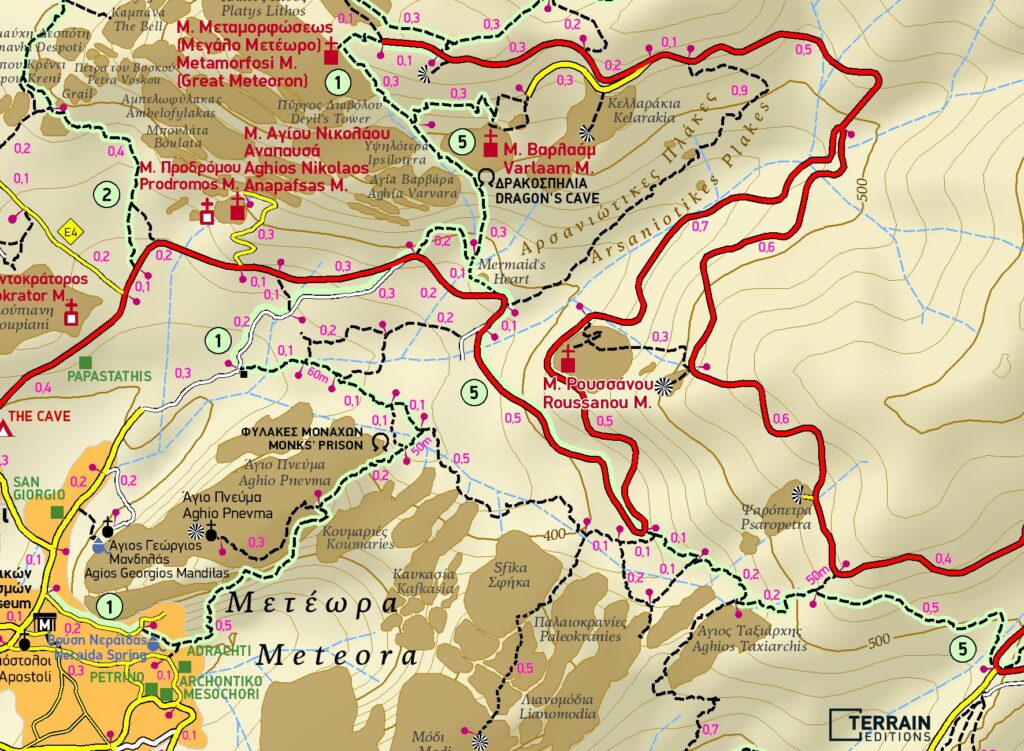
The trails of Meteora
It’s a real pity that there’s absolutely no marking on the Meteora trails. This area could become a top cultural hiking destination in Greece, since it combines a unique natural landscape with impressive cultural wealth (the Byzantine monasteries). The TERRAIN hiking map records with precision all the accessible trails in the area, but you’ll also need a good step tracker app to be able to measure the distance, a compass, and great sense orientation to not get lost. Wherever you are in Meteora, you’ll be amazed by the landscape’s beauty, but we particularly recommend seven routes that offer the best hiking experience in this area.
1. Kastraki – Agio Pneuma – Varlaam monastery – Great Meteoro (distance: 2.4km, duration: 1 hour and 10 minutes)
A gorgeous and relatively easy hiking trail that will take you to two of the most beautiful monasteries of Meteora. It starts at the east edge of the village, at the end of the path behind the Museum of Geology Formations. The path goes up, in the shade of the vertical south side of the impressive Agio Pneuma rock. One of the oldest hermitages in Meteora is built on it, and looking at it from below, it’s very hard to imagine how the monks got up there, but after about 500m (from the beginning of the trail) you’ll see the part of the trail carved in the wood leading to the top, from where you can enjoy the amazing view – however it has many exposed, dangerous parts, so you need to be very careful.
The moment you cross the main paved road, you’ll enter the most beautiful part of the route, a path built between the Meteora rocks, surrounded by thick vegetation, About 400m later, you’ll find yourselves at a crossroads that goes uphill on the right (east) and after about 300m ends ups at the Varlaam monastery. The main path continues north and uphill between the huge rocks to end, after 200m, at the Metamorfosi tou Sotira monastery.
2. Doupiani – Ypapanti monastery (distance: 2,42km, duration: 50min)
Leave your vehicle – or walk – to the clearing next to the road, right after the imposing Doupiani rock, a training climbing field where you can look at the climbers practicing on the rock. The trail starts about 100m after the crossroads with the paved street and 200m before the crossroad to Anapafsas monastery.
The biggest part of the trail goes through a thick oak forest and offers a great view from the impressive rocks at the north edge of Meteora. From the Ypapanti monastery you can continue east until the end of the dirt road, and from there follow part of route 6 south, and then part of rout 1 to return to Kastraki (the distance of the circle route: 6km).
3. Kalabaka – Agia Triada monastery (distance: 1.3 km, duration: 50m)
The trail starts northeast of Kalabaka, at the end of the Agia Triada street. It’s an easy route on a wide, clear path between the impressive rocks at the south edge of Meteora. About 400m after the starting point, you’ll come across a crossroads: to get to the Agia Triada monastery you need to go right (east) and after about 900m you’ll reach the monastery. If you continue straight, after about 700m of an uphill trail between the thick forest and the impressive rocks you’ll come across route 5 that you can follow left (northwest) to get to the Roussanou monastery, the Varlaam monastery or the Great Meteoro.
4. Kalabaka – Agios Stefanos monastery (distance: 4km, duration: 2 hours)
At the east entrance of Kalabaka, follow the main Trikalon street and right after Divani hotel, turn right on Zaharia Pseira street and head northeast until its end, there you need to head east on the dirt road. At about 1,200m from Trikalon street, you’ll find the trail on your left, going north uphill. After about 400m, you’ll reach the chapel of Analipsi. Continue north on the dirt road, and at 50m from the chapel, turn left on the path. This part of the trail, until the Agios Stefanos monastery, is magical, especially in autumn, among the thick oak forest. The path ends at the monastery’s back yard, where unfortunately the nuns have placed a large iron gate that prevents you from reaching the monastery that can be seen 100m ahead of you. So, you’ll have to head towards the Pirgos top, north of the monastery (the view from there is amazing) and reach the monastery by going down to the paved road. The three parts of the routes that continue north from the Pirgos top allow you to continue your hike on route 5 towards other monasteries. Another great choice is going to the Agia Triada monastery and from there going on route 3 to return to Kalabaka.
5. Great Meteoro – Long circle (distance: 5.9km duration: 2hours and 15min)
This is the most enjoyable hike in Meteora, if you like walking in the woods. Start at the parking lot of Great Meteoro and follow the path that goes uphill on the rock, northeast. After 300m, you’ll reach a five-point fork on the road, follow the road east. A great spot to rest is the chapel of Agios Athanasios, at about the middle of the route, that you can reach with a small 400m detour.
6. Great Meteoro – Vlahava monument – Varlaam monastery dependency (distance: 2.1km, duration: 35min)
A great hike on the rocks of Meteora, with an amazing view of the thick oak forest and the Tranos Lakkos river banks, covered in plane trees, in the north. By making a small detour, you can visit the abandoned monastery of Ypapanti and the ruins of the Agios Dimitrios monastery right next to it, and also the top of Ftelia rock that has a stunning view.
7. Panagia Kanaliotissa, circle route (distance: 3.1km, duration: 1 hour and 10min)
Head towards the Varlaam monastery dependency, in your car, and about 300m before the monastery, go right (east) on the dirt road, until it ends. A lovely circle route among the thick oak forest starts there that takes you by the chapel of Panagia Kanaliotissa, then goes uphill the wooded slope, southwest, and then by the creek northwest to bring you back where you started.
8. Great Meteoro – short circle rout (distance: 1km, duration: 20min)
A short and very easy hike – more of a stroll – that we allow you to get a great taste of the gorgeous Meteora nature. You need to go through part of an oak forest, walk on top of a rock and enjoy the view of the forests and creeks in the north, you’ll see monasteries from up high, and all this at just 1,000 distance.
9. Kalabaka – Kastraki (distance: 2.1km, duration: 1 hour)
The first part of this route is a lovely trail right at the foothills of the Badova rocks, Agia and Amparia. The second part includes walking on a stretch of paved and dirt road, and the third and last part is also a gorgeous path in the shadow of the rocks Pixari and Marmara. It’s worth making a detour to visit the Agios Nikolaos Kofinas monastery, a large cave that has been turned into a six-storey skete.
Climbing
The impressive Meteora rocks are a unique climbing destination. The combination of the conglomerate rock with the gorgeous landscape, the fact that each route ends on top of these majestic rocks with the amazing view, as well as the cultural heritage of the area is one-of-a-kind. Almost 800 climbing routes in 15 climbing fields, ranging in difficulty, offer a special climbing experience. You can find detailed technical information on the Meteora climbing fields in the climbing guide “Sport Climbing Guide/Meteora and Theopetra” by local climber Vangelis Batsios, and in the climbing guide, “Greece Sport Climbing/The best of” by Aris Theodoropoulos.
In addition, TERRAIN has just published a detailed hiking map in 1:12.500 scale, that includes all the local paths, guesthouses, churches, monasteries, museums and every sight in meticulous detail.
You can buy it in shops in Kalabaka or here: http://www.terrainmaps.gr/#products. You can also digitally download it on your phone from Avenza Maps site here: (www.avenzamaps.com).








